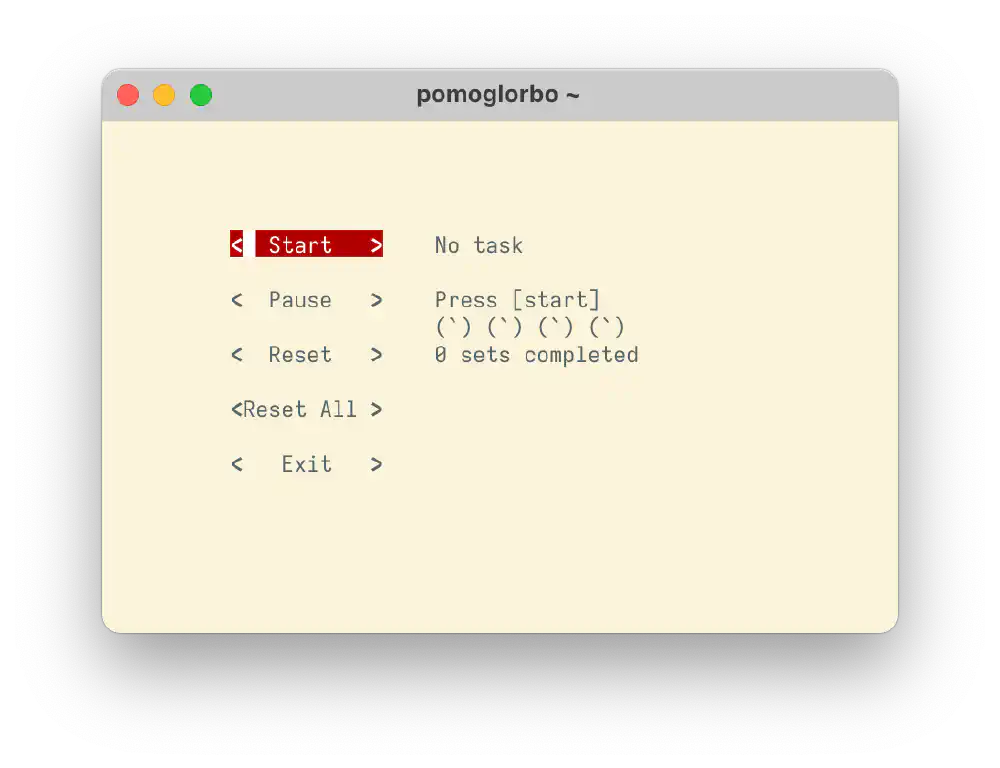Here’s a side project I’ve been working on for the last months:

A screenshot of Pomoglorbo in a terminal Open in new tab (full image size 43 KiB)
Pomoglorbo is a text user interface (TUI) based productivity timer for studying, working, and all other activities that require you to focus for long periods of time. Pomoglorbo has been forked from pydoro. The Pomoglorbo timer runs in your terminal, is lightweight, supports many environments, and can even be run over SSH.
About the Pomodoro technique
Using the Pomodoro Technique, you can structure your work into short phases of work with short breaks between them. Typically, a Pomodoro, the smallest unit of work, is 25 minutes long, and is followed by a 5 minute break. After doing this for four times, a longer break follows. The most common pattern of doing Pomodoros is:
- 25 minutes work
- 5 minutes short break
- 25 minutes work
- 5 minutes short break
- 25 minutes work
- 5 minutes short break
- 25 minutes work
- 20 minutes short break
- Go back to 1.
Another essential part of the Pomodoro technique is deciding what to do during each Pomodoro and never starting one without a plan. It’s useful to break apart work so that the elements fit within a single Pomodoro. This is somewhat like time boxing in Agile development.
How to use Pomoglorbo for Pomodoros
Pomoglorbo is a CLI based app. It requires some knowledge on how to install Python packages on your computer.
Pomoglorbo is distributed as a package on PyPI. The easiest way to get started is by installing the pip package using a tool like pipx. See the previous link for instructions on how to install it on macOS, Linux, and Windows. If you have any problems installing Pomoglorbo on your system, contact me using the email address at the bottom of this page.
Once you have pipx on your computer, you can install and run Pomoglorbo using the following command:
pipx install pomoglorbo
After running this, you may see something like the following output:
installed package pomoglorbo 2024.6.18.post2, installed using Python 3.11.9
These apps are now globally available
- pomoglorbo
⚠️ Note: '/Users/justusperlwitz/.local/bin' is not on your PATH environment variable. These apps will not be
globally accessible until your PATH is updated. Run `pipx ensurepath` to automatically add it, or manually
modify your PATH in your shell's config file (i.e. ~/.bashrc).
done! ✨ 🌟 ✨
If you have set up your PATH variable correctly, you can now run it by running
pomoglorbo, or you can also try:
pipx run pomoglorbo
The initial screen from the screenshot at the beginning of this post is going
to greet you. Now, you can start your first Pomodoro by making sure that
<Start> is selected using the arrow keys and then pressing enter.
You can always adjust the configuration to your liking. All available configuration
variables can be found in the
Repository config.py file
An example configuration file can be found here.
By default, Pomoglorbo searches for the configuration file in your
XDG_CONFIG_HOME
under pomoglorbo/config.ini, which for many people may look like the
following:
# $HOME is the path to your home folder
$HOME/.config/pomoglorbo/config.ini
Got any questions about Pomoglorbo configuration? Feel free to send me an email.
Try installing Pomoglorbo as a Nix flake
Pomoglorbo is also available as a
Nix flake.
You can look at my home-manager Nix configuration
here
to see how I have configured Pomoglorbo and install it as a Nix flake.
Pomoglorbo and pydoro
As mentioned in the beginning, Pomoglorbo has been forked from the original
MIT-licensed pydoro last year. I like that pydoro uses
Click, to build the TUI and having command
line hooks that can be configured in a configuration .ini file. On the other
hand, I wanted to have more configurability for CLI arguments, and the UI used
up a lot of space in my terminal.
I have also used this as an opportunity to rewrite the original OOP based UI with Python Data Classes, and have added rigorous Mypy base type checking. I have modeled Pomoglorbo as a state machine, and used Python’s new match expressions to make sure that no invalid state transition can happen. Timer software with different state transitions are a perfect use case for implementing state machines.
During the rewrite, most of the original code has been rewritten, but many parts, especially the interface design, come from pydoro. If you would like to try out the original version, give pydoro a try.